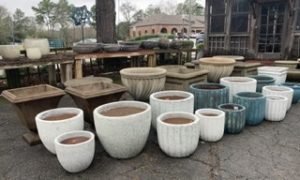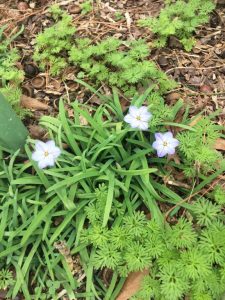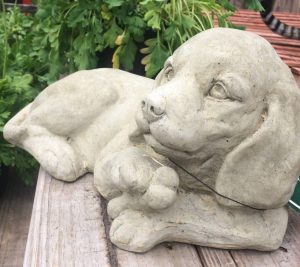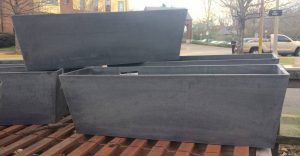Category Archives: Spring

Foxglove – Plant It This Fall For A Beautiful Spring Display!

Foxglove…
Foxglove, Digitalis purpurea, is the quintessential English garden flower. It’s beauty has graced landscapes of great gardeners for hundreds of years, as well as those of more modest means.
Considered a biennial, foxglove is purchased as small transplants in the fall, growing through the winter and reaching their peak flowering time as the roses begin to bloom here in Birmingham.
Plant them in a partially sunny spot, ideally one that will receive some shade in the afternoon. This is especially helpful as temperature begin to rise in the spring and will help them bloom longer. Be sure your soil is loose, and add soil conditioner, shredded leaves, or compost if necessary. Mulch them with shredded pine bark or pinestraw after planting and keep them watered during dry spells.
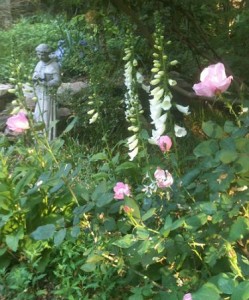
Foxglove and roses in my early spring garden
Foxglove look particularly lovely against an evergreen backdrop or a wall of some sort. Combined with other spring annuals and roses, they are reminiscent of a classic cottage garden.
Once they’re through blooming, plants can be left standing to drop seed, (You’ll see baby plants the following summer if this happens.) but they do get a bit bedraggled looking at this point, and I prefer to pull them out, replanting each fall.
Look for a video on our YouTube channel on foxglove in October, 2022. We’ll try to have other informative videos as well, so if you like them, subscribe!
By Kris Blevons

One April Saturday
It was a spring Saturday in April, and the day before Easter, a steady, busy day with all sorts of customers, everyone in good spirits. There were young couples with children, husbands and wives out and about on the holiday weekend getting plants for projects, an elderly man with two relatives helping him select his purchases – he used to come in regularly, but now we see him only on holidays. We got him a chair and he sat comfortably while his family brought him plants to look at and choose from.
More and more people came and went, some with one or two things, others with many flats and pots set out by their cars, their children clamoring, wanting to know where the cats were so they could pet them.
I noticed two women, the older one in her 70’s with who I assumed was her daughter. They kept a bit to themselves, walking and looking. I asked if they were finding what they needed, and the older woman said “Yes,” and turned away, so I left them to look on their own. A while later I checked on the daughter, and she pulled out her phone to show me a picture of the area they were trying to find some plants for, saying they lived 3 hours south. She also told me her brother had passed away almost two weeks before and she thought the trip up to Birmingham to buy plants would be good for both of them.
I looked at the picture, an overhead shot from at least a third floor window onto a formal garden below. “Oh, how beautiful!” I said. “The center area used to be a pool,” the daughter explained, “and we want something for the large planter in the center where it used to be and some plants to fill in the quadrants around it.” By this time her mother had seen us chatting and joined us. She too told me that they were from a few hours south, not mentioning the loss of her son. But knowing that this was not a simple road trip to buy plants but something they’d decided to do as an antidote to their grief felt very special.
 I chatted with them, helping them choose interesting and heat tolerant plants that would work in their new space. “Do you know what gomphrena is?” I asked. When I found out they didn’t, I said, “Oh, it’s a tough, tough plant, one of my absolute favorites, and we have a special one that everyone loves. It’s a carmine pink, and so beautiful! It is a bit of an ugly duckling in a pot, but once it’s planted and growing I think you’ll love it too, and it will hold up through the heat of summer.”
I chatted with them, helping them choose interesting and heat tolerant plants that would work in their new space. “Do you know what gomphrena is?” I asked. When I found out they didn’t, I said, “Oh, it’s a tough, tough plant, one of my absolute favorites, and we have a special one that everyone loves. It’s a carmine pink, and so beautiful! It is a bit of an ugly duckling in a pot, but once it’s planted and growing I think you’ll love it too, and it will hold up through the heat of summer.”
By the time we were finished, with their selection of plants by the car, they were both visibly more relaxed and smiling. I feel certain the daughter probably wondered why she’d told me about the recent death of her brother, but I’m so glad she did. Knowing of their grief, of their special mother daughter trip together, helped me help them.
And I hope their grief was eased, even for just a little while, at a bustling garden shop on a spring Saturday in April.
By Kris Blevons

Edgeworthia chrysantha…A Great Shrub To Grow
I can’t imagine why, after all these years, this is the first I’m writing about one of my favorite shrubs, Edgeworthia chrysantha, or paperbush.
 This wonderful plant for our area has interest in all the seasons, culminating with fragrant blooms in spring.
This wonderful plant for our area has interest in all the seasons, culminating with fragrant blooms in spring.
Its open, well branched growth habit and winter silhouette in the garden is superb, as buds that form in the fall add interest and promise through the long winter months.
After the bloom period is over, the leaves begin to emerge with silky, white hairs, with a lovely, bluish color and slight silver tint.
The scent is what will knock you out though. It’s slightly spicy and is one of those fragrances that you’ll get a hint of before you see the plant. Believe me, everyone will ask what it is and where you got it the first time they come across it.
Edgeworthia is native to woodlands in the Himalayas and China. The inner bark can be used to make paper, hence the name paperbush. Edgeworthia is grown in Japan expressly for making paper out of the inner bark…for bank notes.
Part shade is the best place to grow your edgeworthia. They appreciate rich soil, never too dry. If you try to grow it in too much sun the color won’t be quite as pretty. Speaking of color, in the fall the leaves turn shades of yellow. Yes, it really does give all season interest!
 Provide it some room wherever you decide to plant it. Its width at maturity will be at least 7 feet wide and as high.
Provide it some room wherever you decide to plant it. Its width at maturity will be at least 7 feet wide and as high.
Mine is very wide but not at 7 feet tall yet. Here you can see it, to the left of the tree in my garden. It seems to be continuing to spread, and has suckered a bit, obviously wanting to take up some more real estate. I think I’ll let it!
If you follow us on Instagram or Facebook you’ve probably seen a new series of shop videos – if not, follow us and check them out! They’re also on our YouTube channel under Oak Street Garden Shop – if you’d like to see more, subscribe!
By Kris Blevons

A Sampling of Statuary and Planters To Start The New Year
Each January the first shipments of planters and statuary come in, and we try to mix it up a bit, ordering some things we haven’t had before along with others that are tried and true.




Whimsical frogs, little animals, a bench for the garden, and more are displayed at the end of the nursery, and they’re easy to browse, especially in the winter months before we fill up with the plants that will take center stage through the spring.

Here’s a glimpse of the offerings so far. More will come in as spring approaches, and don’t forget to take a look in the greenhouse as well for all kinds of smaller pots and fountains of different sizes.





The February Garden, Dreaming Of Spring
Recently on a weekend off I spent a bit of an afternoon doing some necessary chores in the garden and much of the rest simply piddling.
I enjoy observing my plantings, checking buds on shrubs and trees, and scratching through the leaf litter looking for signs of life from perennials I know are there but just not awake yet.
I call these tours of the garden ‘taking a walk.’ When I say that, my husband knows I’ll be gone a while, and, if it’s in the afternoon, he usually has a glass of wine ready for me, knowing I’m not planning on doing any serious work.
Earlier in the day I’d cut back the Carex ‘Blue Zinger’ that is slowly beginning to take over the corners of some raised beds where I’d planted it a few years ago.
The Carex family is a tough group of plants, and this one has a beautiful blue hue that I admire. A couple of other carex in my garden include ‘Evergold’, a cream and green variegated selection, and ‘Everillo’, a chartreuse beauty that lights up any shade area its placed in.
The larger areas of mondo grass will be tackled soon, as February is the month to get all the ornamental grasses cut back to make way for fresh new growth.
Some plants hug the ground tightly, as if hanging on for dear life. The strawberry begonias are like that. I know in another month or so though that their delicate white flowers will be reaching for the sky.
This winter saw a few cold snaps, but even so, with this string of very wet days and warmer temperatures, the pansies will hopefully begin to look happier, not hunkered down and miserable but plump and full of buds and blooms.
I deadhead the ones that need it and notice the poppies I’d planted last fall are taking on their characteristic spring fullness as well.
The snapdragons have green growth beginning to show below the brown tops, and there are larkspur seedlings coming up between them too. Sometimes it’s a waiting game, requiring patience to see what will be.
The tiny ipheion are beginning to bloom, the earliest of my bulbs, their flowering always coinciding with the first of the veronicas, ‘Georgia Blue’. I make a note to combine these two for an early symphony of blue next year.
Of course the Lenten roses are blooming, stalwarts of the shade garden, and I diligently pull seedlings that come up each year too close to a patch of prized trillium.
This year I’ve added some hybrid Lenten roses in beautiful hues with blooms held proudly – they’ll stay in one spot rather than seeding themselves and cavorting through the garden like the others.
I turn away and spot the very first bloodroot bloom and immediately go to check another area I know they’ll be, but there’s no sign of them. Microclimates at work!
Golden leaved Sedum makinoi ‘Ogon’ is filling a small trough planter and looks none the worse for the winter. It’s also in other containers and in the ground as well.
 Sedum makinoi grows at the very top of the rock outcrop, happily mingling with resurrection fern. I clamber up the rocks, to check it out.
Sedum makinoi grows at the very top of the rock outcrop, happily mingling with resurrection fern. I clamber up the rocks, to check it out.
I continue on with my walk and notice the ipheion isn’t blooming quite yet at the base of a bird bath.
 Native azalea buds are full of promise. I love their honeysuckle-like fragrant blooms and can almost smell them, but no, that’s the edgeworthia. It and the daphne are at their best now and perfume the air. Next month will be the native azalea’s time.
Native azalea buds are full of promise. I love their honeysuckle-like fragrant blooms and can almost smell them, but no, that’s the edgeworthia. It and the daphne are at their best now and perfume the air. Next month will be the native azalea’s time.
I make my way back to the house, past the Spiraea ‘Ogon’, in full bloom with it’s tiny white flowers. I know that froth of white will soon give way to chartreuse, airy foliage, yet another promise of spring on a gray, February day.
By Kris Blevons

It’s A New Season… Planters For 2018
New planters arrive in January, filling one end of the nursery, and 2018 was no different. Right on cue, mid-month the delivery truck arrived and pallet after pallet of planters were unloaded and priced.
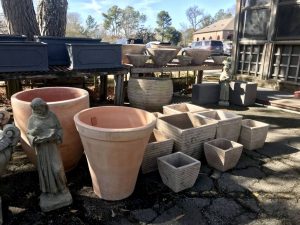 We’ve purchased from this supplier for almost 30 years now and have always been certain of their quality of workmanship.
We’ve purchased from this supplier for almost 30 years now and have always been certain of their quality of workmanship.
So if you’re looking for one planter or a grouping, we might just have what you need, including a selection of animal planters for your whimsical side.
You’ll find Saint Francis, the patron saint of all animals and nature, and Saint Fiacre, the patron saint of the garden.
Not to be left out are the yoga cat and frog and buddha statuary for that calm space in your landscape.
 There are traditional and very beautiful cast stone planters with simple, clean lines.
There are traditional and very beautiful cast stone planters with simple, clean lines.
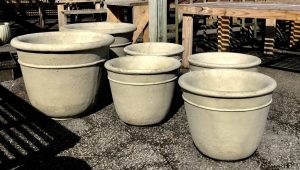
The selection of lightweight planters will expand as the season goes on.
This is a sampling of what is available now. Please keep in mind that this will change as the year progresses, so if you’re looking at this post in July some of what is pictured may no longer be available. Remember, the early bird gets the worm!

Early Spring in the ‘Better Late Than Never’ Garden
The past week we had two nights below freezing, and I wondered how the ‘Better Late Than Never’ Garden would fare across the street from the shop. I’d been checking it regularly, hand weeding the henbit. This pesky weed (Did you know it’s edible?) was determined to come up between the ferny larkspur, flat poppy leaves, and the blue gray foliage of bachelor buttons that looked like they were just beginning to stretch up toward the sky.
This garden is truly a stepchild of the garden world. I was out of town the day the temperatures were forecast to drop. I knew everyone at the shop was moving the inventory into the greenhouse – a big job and one that I’m sure would take a good part of the day. I let the garden go, hoping for the best.
With the first cursory glance as I parked my car across from Emmet O’Neal Library and walked up the sidewalk toward the garden,, everything still looked green, a very good sign. Looking more closely, the only damage appeared to be to the few sunflower seedlings that obviously didn’t get the memo that it was much too early to sprout, and were now black and quite dead.
Maybe the fact that I didn’t thin the crowded seedlings out like you’re supposed to kept everything warm, snuggled up together, I thought. Whatever the reason, it was good to spot even the sweet peas that I’d recently planted on one of the front arbors. I was looking forward to seeing them begin to climb up the fishing line I’d strung along the metal of the support.
I’m hoping some of the poppies coming up near the arbor in the front beds are the gifted seeds from a friend. She was given them on a garden tour to Maryland last spring and offered them to me to try, saying the color was exquisite. I can’t wait to see!
Though there are always sights like that to look forward to, many large flowering shrubs and trees in our landscapes may well have been affected by the last cold spell, their buds frozen. One of my gardening friends mentioned she was particularly worried about her summer blooming hydrangeas, and I’m concerned about my fringe tree blooms.
Only time will tell, and we’ll just have to keep our fingers crossed. Until then, enjoy the beauty apparent in the fresh green hue of unfurling leaves and the return of the many pollinators that grace our gardens and landscapes. Be prepared also to plant the flowers, herbs and perennials that they appreciate…and that we do as well. Happy gardening!
By Kris Blevons

New Statuary for Spring 2017
When the big crates of statuary arrive, it’s a sure thing spring is just around the corner. Here’s a look at a few of the pieces that came in recently. Whimsical animals, and pretty planters that struck our fancy and we hope will tickle yours too.
They’re even better in person!

Spring To Summer In The Garden – It Happens So Fast!
 A southern garden, not unlike like gardens elsewhere, is in constant change one day to the next, a living work of art subtly shifting in quiet or awe-inspiring ways. But here in Birmingham, Alabama, we’re also able to revel in every season…each spring, summer, fall, and even winter, since, for better or worse, there’s no real down time, no blanket of snow to envelope the garden in silence. Each season slides easily into the next, with the appropriate and perfect accompaniment of plants.
A southern garden, not unlike like gardens elsewhere, is in constant change one day to the next, a living work of art subtly shifting in quiet or awe-inspiring ways. But here in Birmingham, Alabama, we’re also able to revel in every season…each spring, summer, fall, and even winter, since, for better or worse, there’s no real down time, no blanket of snow to envelope the garden in silence. Each season slides easily into the next, with the appropriate and perfect accompaniment of plants.
 The mental transition from spring to summer is the hardest for me though. I want the perfect spring days to go on and on and wish the peonies, poppies, pansies, bachelor buttons, Japanese roof iris, and foxglove could bloom forever. But I know the relentless heat will soon arrive to stay for good and the earliest of the garden bloomers will go as the temperatures and the humidity rise.
The mental transition from spring to summer is the hardest for me though. I want the perfect spring days to go on and on and wish the peonies, poppies, pansies, bachelor buttons, Japanese roof iris, and foxglove could bloom forever. But I know the relentless heat will soon arrive to stay for good and the earliest of the garden bloomers will go as the temperatures and the humidity rise.
So, I’m mindful each day to appreciate the spires of foxglove and blooms of colorful snapdragons I planted on cool fall days last October and that are blooming now, even as I tuck in my usual summer annuals of zinnias, lantana, gomphrena, and more in my hot, sunny front bed. As I plant I pull out many spent pansies and tired poppies, choosing to leave those that are still adding color.
Many customers I see each day have completely pulled out their scraggly pansies and are ready to move on. They walk out of Oak Street Garden Shop loaded up with top soil or soil conditioner to loosen the soil, PlantTone to feed it, and lots and lots of plants. They gather perennials that will come back each year, annuals for lots of continuous color, and herbs and vegetables to harvest through the summer.
 This year I’ve decided to add a new tall salvia selection called ‘Amistad’. I’ve fallen in love with its beautiful rich purple blooms and think it will be the perfect compliment for the yellow day lilies and other hot colors I usually use in this spot.
This year I’ve decided to add a new tall salvia selection called ‘Amistad’. I’ve fallen in love with its beautiful rich purple blooms and think it will be the perfect compliment for the yellow day lilies and other hot colors I usually use in this spot.
African blue basil is another addition this year that I’m planting for the honeybees. On an arbor I’ve decided to put a Malabar spinach plant, a fast growing and beautiful vine whose tender new leaves are edible. Trying new plants, and even different selections of those I’ve used before, makes each season a little different and a lot of fun.
It was a hot day today. I survey the garden as I water my new plantings in, eying a spot previously occupied by yellow violas. Yes, some bat face cuphea would look just right there, and I think the hummingbirds would like it too.
By Kris Blevons

Planters and Statuary for Spring 2016
 Soon we’ll be unloading spring shipments of shrubs, herbs, flowers for garden beds, pots, and more. For now though, two large shipments of planters and statuary have arrived, and we’re waiting on a third from a new supplier.
Soon we’ll be unloading spring shipments of shrubs, herbs, flowers for garden beds, pots, and more. For now though, two large shipments of planters and statuary have arrived, and we’re waiting on a third from a new supplier.

There are cast stone planters, but light weight alternatives are available as well, easy on the wallet, (And the back!) too.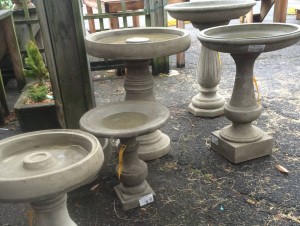
Winter is a good time to take a walk through your yard with a critical eye. Might there be a spot for a bird bath? One can easily be worked into existing planting beds near the cover of shrubbery, or used as a focal point to draw the eye to a particular area of your landscape. Try to locate it where you can see your feathered friends from inside your home as well.
 These cast stone bird baths are classic shapes, and will add timeless beauty to your garden. And, while we’re on the subject of birds, why not give them a place to live by adding a succulent roof bird house. They make quite a stylish abode!
These cast stone bird baths are classic shapes, and will add timeless beauty to your garden. And, while we’re on the subject of birds, why not give them a place to live by adding a succulent roof bird house. They make quite a stylish abode!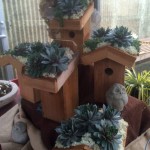
Do you or someone you know have chickens? So many people do these days, and our statuary suppliers have jumped on the bandwagon, offering Henrietta the hen, and two versions of a rooster.
If you fancy a conversation piece for your yard, one of these just might fit the bill! Any of them would also make a great gift, and since they’re cast stone they are meant to last a long, long time.
 Planters, bird baths, chickens, roosters – and I haven’t even mentioned our trio of charming gnomes – what fun it would be to come across one or more of them in a garden!
Planters, bird baths, chickens, roosters – and I haven’t even mentioned our trio of charming gnomes – what fun it would be to come across one or more of them in a garden!
Perhaps you’re more inclined toward religious statuary…we have Saint Fiacre (The patron saint of the garden.), Saint Francis, or the choice of Buddhas for your tranquil piece of earth.
Soon more and more plants will arrive, and spring will too. Until then though, stop by to stroll the greenhouse and browse. You might spot the perfect planter, a gift for a friend – or both!
By Kris Blevons
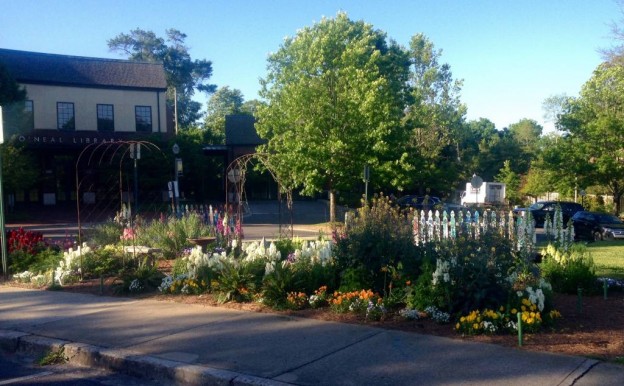
It’s Spring In The ‘Better Late Than Never Garden’…
 Last fall the little plot that I’ve come to call the ‘Better Late Than Never’ garden was gradually planted with foxglove, snapdragons, poppies, delphinium, bachelor buttons, ornamental kale, pansies, and violas. Dashing across the street between customers and shop business to add plants and tending it very early in the morning, the garden slowly filled in.
Last fall the little plot that I’ve come to call the ‘Better Late Than Never’ garden was gradually planted with foxglove, snapdragons, poppies, delphinium, bachelor buttons, ornamental kale, pansies, and violas. Dashing across the street between customers and shop business to add plants and tending it very early in the morning, the garden slowly filled in.

There were a few poppies…
As with any garden, there were successes and failures. I’ve come to accept that nature always has the upper hand and not to take it personally when something doesn’t go exactly as planned. Take the poppies, for example. This year, for some reason (I think it was all the rain late winter into early spring.), they just didn’t fill out like they usually do. Disappointing for sure, but the snapdragons more than made up for the poppies lackluster performance.

Yellow snapdragons and white foxglove…
I usually have lots of larkspur that reseed in my garden at home. This year I don’t see much coming up at all. Again, it could be the rains or
even the frigid spell late winter this year. It didn’t come up in the shop garden either. Oh, well! The foxglove is beautiful and is putting on quite a show with the delphiniums!

Red Russian ornamental kale adding it’s yellow blooms as it bolts…
My strategy is to have a variety of plants, knowing that there will be some failures but many more successes. Also, between business at the garden shop (and a personal life), I’ve tried to keep the garden weeded and tended as much as possible.
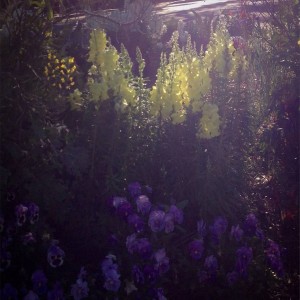
Early morning light on the snapdragons and pansies…
In a perfect world, there would be endless help, every foxglove would be staked, the bachelor buttons would have been cut back at least once to keep them from flopping, the snapdragons would have supports around them, and the pansies and violas would have more constant deadheading…but whoever said life was perfect, and wouldn’t that actually be a little boring?
The nursery is full of plants for your summer garden. Spring is all about renewal and hope for a new season, so plant your garden with things you love and try something new too. I’m not sure what this summer will hold for the ‘Better Late Than Never’ garden. I do know we’ll enjoy the beauty of all that’s growing now through our busy spring season and get it planted, finally…(Better late than never!).
Happy spring planting to all of you, remember to maintain the garden as best you can, and always enjoy observing life in your garden too…
Posted by Kris Blevons

Bounce Impatiens – These Are Resistant To Downy Mildew Disease!

Bounce impatiens -photo courtesy Ball Hort
We knew plant breeders would be working double overtime to come up with an alternative to bedding plant impatiens that have been subject to downy mildew disease the past few years and are so happy to hear of a new impatiens series called Bounce. We’ll be offering these new plants this spring and will be trying them in our own gardens. This is the description from our local grower’s website:

Bounce impatiens – photo courtesy Ball Hort
“Introduced for 2015, the Bounce series of Impatiens is bred to resist Downy Mildew, have the bloom count of the classic walleriana-type impatiens (Super Elfins, Dazzlers, etc..) and perform in both shade and sun! Possibly best with some afternoon shade here in the Birmingham area. The series is named for its ability to bounce back from a wilt without dropping its blooms.”

Bounce impatiens – photo courtesy Ball Hort
This is such good news! A recent conversation with this local wholesale grower revealed that, while the color range isn’t extensive (yet), it does offer white and varying shades of pink as well as a lavender. They can easily be planted 15″ apart in a garden bed and will fill in beautifully as shown in the picture above.

Bounce impatiens – photo courtesy Ball Hort
In addition to the Bounce series of impatiens, Sunpatiens are also a good choice for disease resistance.
You will still see the downy mildew prone Dazzler, Super Elfin and other impatiens for sale around town. We will order them for you, at your request, but will sell them with the warning that they are susceptible to downy mildew disease.

Haven’t Been In Lately? Here’s What We’ve Been Up To…

Red tulips, a pretty pink hydrangea, a rex begonia and greenery…

Cyclamen, Callas and Daffodils are a cheery mix…

This arrangement was to celebrate the birth of a baby girl…

February is full of bright colors…primroses, hyacinths and tête á tête narcissus…

A pretty arrangement for Valentine’s Day. This would be pretty for any occasion this time of year though…this one showcases a calla and a beautiful pink hydrangea…

A customer’s container became home to a bird’s nest Fern and agave…
Outside the greenhouse can look a little drab this time of year, but, if you’ve just passed us by, have you ever missed out!

Primroses in the greenhouse…
The greenhouse has been packed full with blooming beauties and with Valentine’s Day just past, we’ve been putting together the prettiest arrangements for gifts and filling containers with all sorts of plants for centerpieces too.

This cork bark planter is filled with succulents, spring bulbs, candytuft and primroses…
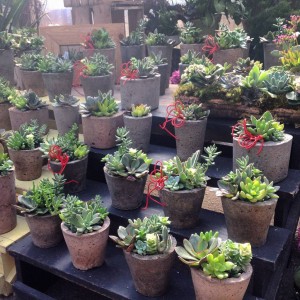
Succulent pots at the front door…

In bloom at the entrance to the greenhouse…
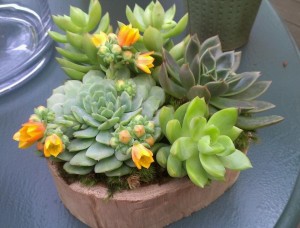
Echeverias blooming in a tiny pot…
Here’s a sampling of what the greenhouse has looked like.

Tacca is getting more adventurous, between getting pets from everyone…

A sweet pot filled with a Rieger begonia, Fern and Ivy…

White and yellow Phalaenopsis orchid arrangement with azaleas and succulents….
Next time you’re driving by, take a moment out of your busy day to stop and smell the flowers!

Cattleya orchids and air plants in the afternoon light…

A calla lily azalea, campanula and fern in shades of purple, lavender, white and green…

Hydrangeas, azaleas and purple campanula

Wire Hearts for Valentine’s Day…

More Samplings of Spring 2015 – Cast Stone Faux Bois Planters, Bird Baths and Statuary

 This blog post picks up from the last one, showcasing more of our newest cast stone statuary and planter offerings for 2015.
This blog post picks up from the last one, showcasing more of our newest cast stone statuary and planter offerings for 2015.
We’ll begin with the faux bois planters in four different sizes. They would be lovely in a rustic, shady setting, complimented with ferns, hostas, heucheras and other woodland plants to emphasize the tree bark effect that faux bois mimics. These are heavy pieces that will definitely anchor their space and won’t tip over or be blown over in storms.
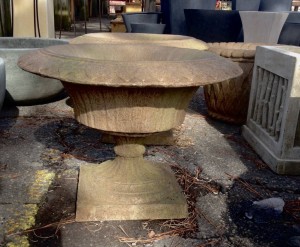 Here too are a few more urn shaped planters. But, unlike many urns, these have a generous planting space, offering enough room for a pretty display of seasonal color or a more permanent choice of a shrub or possibly herbs.
Here too are a few more urn shaped planters. But, unlike many urns, these have a generous planting space, offering enough room for a pretty display of seasonal color or a more permanent choice of a shrub or possibly herbs.
 Bird baths add elegance and style to any landscape in addition to their all important purpose of offering water to our feathered garden inhabitants. These timeless designs could work in any setting.
Bird baths add elegance and style to any landscape in addition to their all important purpose of offering water to our feathered garden inhabitants. These timeless designs could work in any setting.
And some smaller pieces: Saint Francis and Saint Fiacré, a Buddha, a sweet little boy reading his book, a gargoyle…the kinds of pieces that need their own special place and make your garden uniquely yours.
 We even have roosters and a chicken – perfect for any of you who keep neighborhood fowl in your yards! They really are fun and are sure to start a conversation over the proverbial fence.
We even have roosters and a chicken – perfect for any of you who keep neighborhood fowl in your yards! They really are fun and are sure to start a conversation over the proverbial fence.
 Finally, three quite different choices: large terra cotta colored planters that could be perfect around a sun drenched pool, a pair of basket weave pots (a classic design), and some dark colored Vietnamese style planters if you prefer a more rustic look.
Finally, three quite different choices: large terra cotta colored planters that could be perfect around a sun drenched pool, a pair of basket weave pots (a classic design), and some dark colored Vietnamese style planters if you prefer a more rustic look.
 So if you’ve been looking for the perfect planters for your home, we just might have what you need. If you’re in the area, stop by and take a look!
So if you’ve been looking for the perfect planters for your home, we just might have what you need. If you’re in the area, stop by and take a look!
As of January, 2016, many of these planters have been sold and new offerings are available. Take a look HERE for the latest planters and statuary.

A Sampling of New Planters for Spring, 2015
 Each January our orders of planters come in for the new year and beyond, beautiful cast stone beauties designed to last longer than a lifetime.
Each January our orders of planters come in for the new year and beyond, beautiful cast stone beauties designed to last longer than a lifetime.
Yes, they’re heavy, but they are also the highest quality available, designed to add value and style to any outdoor landscape.

And, if you’re in the area, remember we deliver too; so no worries about how you’ll get them home.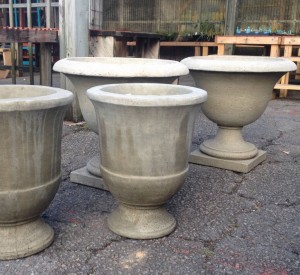
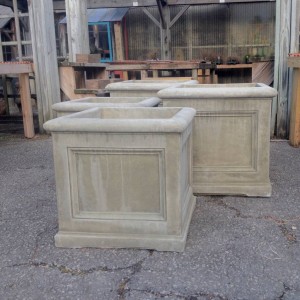
This is just a tiny sampling of what we have in stock now, and there’s more to come, including light-weight options. As you can see, there are all sizes and shapes offered to compliment any style home.

Some are elaborate…or you might want something with clean, classic lines. If you’ve been thinking about adding some planters to your home landscape, now is the time to peruse some great options.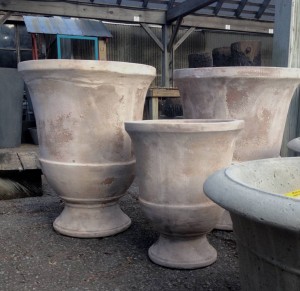
 In addition to the many planters, there are also statuary pieces of Saint Francis, Saint Fiacre and more. Stay tuned for pictures of those in future posts.
In addition to the many planters, there are also statuary pieces of Saint Francis, Saint Fiacre and more. Stay tuned for pictures of those in future posts.

The ‘Better Late Than Never Garden’ – A Winter Update

Tucking in winter plants around fall annuals, late fall…
The ‘better late than never garden’ is certainly living up to its name, since it was planted at the beginning of November 2014, and most of it finished just prior to the hectic holiday season, a full month later than I would have liked. This ‘better late than never’ schedule is working out okay so far, though, as the plants are growing steadily. Of course, more updates will follow, documenting successes and the inevitable failures that every garden and gardener has.
Most of these pictures were taken quickly very early on a mid-December morning in the middle of the holiday rush. Since there were other things that needed to be done, I couldn’t linger; but now, with the new year and more time, here’s an overview of the planting process and selection in this ‘better late than never’ winter garden.
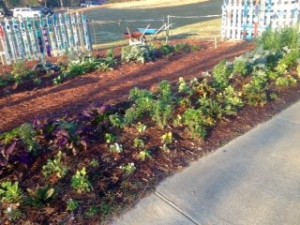
Mid-December. Mulched and growing…
Let me admit right off that I’m not a “garden designer”. I can’t tell you that I drew a beautiful rendering of what I envisioned this garden to be come spring. No, the reality is that I grabbed a few packs of this and a few pots of that (usually in the middle of a busy day), raced across the street trowel and plants in hand, and plugged them in wherever I felt they worked best. So, in that way, little by little and over and over, the garden was planted. Time, attention, and the weather will determine how it turns out this spring.

Violas, delphinium, poppies, kale, curly parsley, bachelor buttons and more growing… Mid-December
I began by planting a few foxglove, delphinium, and bachelor buttons under the still blooming summer tithonia. Then, when it was finally pulled out (Better late than never too!), pansies, violas, and sweet alyssum were added to large spaces that opened up.

Red Veined Sorrel, Rumex sanguinea, in the winter garden…January
Since the summer annuals were pulled out of them first, the two front beds were planted the earliest with snapdragons, poppies, bachelor buttons, chard, curly parsley, dill (The dill will eventually freeze at some point.), red veined sorrel, ‘Bull’s Blood‘ beets, kale, and mustard “Red Giant“. There’s quite a mix of annuals, herbs, flowers, and even bulbs (dwarf narcissus and ipheion) in each bed.

The ‘better late than never garden’ in mid-December…
A good layer of mulch is really important for your winter garden. Some folks start with a completely empty bed, add the mulch, then plant through it, a great method and easy to do. Of course, I did just the opposite. I had the time to plant before I had the help for the mulch! So, inevitably, there I was, mulching in the dark before the first cold snap of the season.
I also made sure everything was watered well before spreading the shredded pine bark around the little plants. There will be many more cold snaps before the winter is through, and I’m counting on this mulch to keep the soil warm since this isn’t a garden that gets babied.

A poppy, in bud, with ‘Red Giant’ ornamental mustard in the ‘better late than never garden’ in January…
For people that don’t have big blocks of time (That’s most of us, I think.), planting a little bit at a time does work…obviously I’m a poster child for it. Now I’m concentrating on keeping winter weeds controlled in the beds, since the two worst offenders, chickweed and henbit, insist on coming up. Don’t let these winter weeds get hold in your garden. Pulling a few every week is far more preferable than tackling them come spring, after they’ve been allowed to smother your pansies and violas.
Have you planted some flowers for spring? If you haven’t, try a few poppies, pansies, or violas since, as you know now, it’s never too late to plant a garden. I’ll keep you posted on our ‘better late than never’ garden’s progress too!

Fall Favorites For Spring Flowers…A Primer On Pansies & Violas

Pansy Matrix Ocean Breeze MIx

Pansy Matrix Sunrise
Fall is planting time here in Birmingham, and pansies and violas are the stars of the show. Even if folks plant nothing else, it’s so easy to put a few of these spring beauties in a little spot in the garden, a pot, or a window box for the winter.

Panola Purple Face & Viola Sorbet Blueberry Cream

Pansy Dynamite Scarlet/Viola Sorbet Antique Shades/Viola Penny White

Pansy Majestic Giants Patricia

Pansy Dynamite Scarlet/Pansy Matrix Orange/Viola Sorbet Yellow
Oh but what a dizzying selection greets you at the garden shop! Tables upon tables of blooms…some diminutive, others large, some with solid colors, others with charming “faces”, all waiting for you to decide which of them to choose to add beauty to your landscape next spring – and even some color through the winter.
One rainy Saturday morning I put together a few sample combinations of pansies, violas, and mixtures of the two to show you a few options available for your planting pleasure…but keep in mind this is just the tip of the iceburg when it comes to playing with color in your garden!
Remember to think about what else will be blooming in your garden come spring. You may not want a pink pansy in front of your orange azaleas (Though I’ve been known to favor pink and orange in certain instances!), so think it through before you decide.
Another consideration to keep in mind is the color of your house. My first summer in our home I decided I wanted an “English Garden” look out front, using pinks/purples and silvers.
I was so caught up in my vision that I forgot this color palette would look like blech in front of the brick – I was unhappy with it all summer and couldn’t wait to tear it all out come fall.
Now I use brighter colors and include poppies – it looks so much better! I save the more muted colors for the back of my house where I play with my “English Garden” and plant everything I want to – including foxglove and snapdragons for spring interspersed with pansies and violas.

Viola Sorbet Purple Duet/Blue Blotch/Banana Cream
The difference between a pansy and a viola is primarily size and shade tolerance. The pansy bloom and plant is larger. Pansies need at least half a day of sun to bloom well; full sun all day is best, but remember, in the spring as the temperatures rise, they’ll play out faster in so much sun.
Violas are smaller in size and the blooms are smaller as well. However, violas put out massive amounts of small blooms and the plants attain a nice rounded size which makes up for those diminutive flowers. Violas can tolerate less sun, though, as with the pansies, at least half a day sun is best.
As for most plants, fertilizing is important. Plant Tone is a good natural (and stinky!) amendment to add to beds in the fall. Incorporate it with a first feeding of Osmocote, which will release its nutrients until the soil gets cold.
Mid-winter apply calcium nitrate to add extra nitrogen. After planting, always water your plants in and apply a good layer of mulch to keep roots warm through cold spells.While plants are blooming be sure to deadhead, (pinch off faded blooms) to keep more buds coming. If you leave old blooms on to die then set seed, this creates a messy looking plant that’s putting all its energy into that seed, not into future blooms.
This is especially important to remember come spring. Don’t be overly concerned if plants aren’t blooming in the middle of winter. This is normal – especially if we have cool, frosty nights. Remember, the real reward comes in the spring!

Pansy Mariposa Peach Shades
Be mindful of winter temperatures – this is the time to watch the weather reports each morning or evening. Pansies are tough plants, but help them out by making sure soil in beds or planters is moist if there are freezing temperatures forecast.
Hopefully these suggestions and tips will be helpful for any of you that get overwhelmed by the choices available…happy planting!

Snapdragons – Plant This Fall for Cut Flowers Next Spring!

snapdragons, poppies and a pass-a-long white dianthus…
Snapdragons! These childhood favorites certainly deserve a space in our spring gardens. Planted in the fall, these annuals will survive a normal Birmingham winter and give us glorious springtime color.
I’ve discovered that since their bloom time always seems to come after the pansies and violas have begun to fade in the late spring heat, that placing them in garden beds intermingled with perennials, roses and poppies is the best way to enjoy them. There’s simply nothing like a spring garden with snapdragons in it – and they are beautiful cut flowers too!
 Snapdragons can be purchased in the fall in cell pack flats and in larger pots as well. Many times they’ll be in bloom. When theses initial bloom spikes are finished, cut them back below the faded flowers. This will ensure they’ll branch and be fuller and more robust. Through the winter the plant’s energy will go into growing roots and strong leaves – the beautiful blooms next spring are your reward!
Snapdragons can be purchased in the fall in cell pack flats and in larger pots as well. Many times they’ll be in bloom. When theses initial bloom spikes are finished, cut them back below the faded flowers. This will ensure they’ll branch and be fuller and more robust. Through the winter the plant’s energy will go into growing roots and strong leaves – the beautiful blooms next spring are your reward!
Be careful not to overwater your snapdragons, especially very young, newly transplanted ones. Let them dry out a bit between watering since their root systems can easily be overwatered at this stage and will not recover from it. If they have been overwatered, the plant will wilt, looking for all the world like it needs water. If, after being given some, your snapdragons continue to look droopy, it’s best to pull them out and try again with fresh plants.
By Kris Blevons

Planting The “Better Late Than Never” Garden For Fall

Chard and poppies mingling with pink gomphrena and the variegated hibiscus…
The owner of Oak Street Garden Shop, Billy Angell, and I have different approaches to gardening, mostly the result of our personalities, I think. Billy is very methodical and precise (not a bad thing), and I’m admittedly more undisciplined and haphazard in my gardening efforts.
I can almost feel him cringing as I yank just some of the zinnias and other spent plants from the “better late than never” garden the other morning, rather than pulling everything out and starting fresh with a completely new planting. I’d gone in earlier than usual to take a look and assess what needed to be pulled out in anticipation of the fall/winter garden. I’ve been worrying that

Bachelor buttons and snapdragons…
as we get busier and busier with the fall planting season, not to mention the craziness of the holidays just around the corner, the garden could fall by the wayside; so the pressure is on!
Now, it wasn’t strictly just a pull some of the plants out mission. I had also brought a smattering of plants with me to plant here and there as holes conveniently opened up. A few iceland poppies, some snapdragons, bachelor buttons, foxglove, red mustard, chard, and kale were all on my to-do list to plant. Now, how all this mish-mash is going to turn out is anyone’s guess, since I’m not starting with a completely blank slate…but that’s half the fun!

Foxglove…under the sunflowers…
This is how I’ve gardened at home for years. In the fall, I pull out spent flowering annuals a little at a time; and, as I do, I add to the garden as holes open up. This works out well because not everything I want is available all at once, and the garden turns over to a new season gradually as summer annuals mingle with fresh plantings.
This year bachelor buttons, foxglove, and iceland poppies appeared in late September; so they’ve gone into the first available spaces in the garden. More of them will be planted as room opens up. Summer annuals that are still hanging in are left to continue attracting late season butterflies and bees until the last will finally be pulled out to make way for the final winter plantings of pansies, violas, and, by seed, larkspur and delphinium. This planting method works well in beds that are a mix of perennials, annuals, and shrubs, too.

Poppies….
So, in the “better late than never garden”, the zinnias, cleome, and the few sunflowers I pull out (There are a lot more sunflowers to go!) make room for a few of each of the aforementioned snapdragons, iceland poppies, foxglove, bachelor buttons, kale, and mustard. We’ll top dress the beds with PlantTone too and will see how the compost is looking in the bins, adding some of it if it’s ready.
In the coming days and weeks the garden will undergo even more changes until, finally, the last plants are in. Then it’s a waiting game until spring, when the real show will begin. Just don’t be surprised if you see us still planting in the dead of winter…I think the “better late than never” garden will always be just that!


